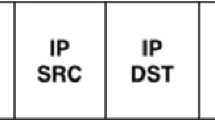Abstract
This paper proposes a novel dataflow architecture called DFNET (DataFlow architecture on the interNET), which realizes a scalable dynamic dataflow computer on a packet switching network. A vast amount of research on dataflow computers has been extensively performed during, in particular, 1970s and 1980s as a promising approach for realizing very high-speed computers. In spite of the large amount of expectations, success of dataflow computer researches is quite limited. The objective of this paper is to present the concept of a scalable and extensible dataflow architecture on a packet switching network, which utilizes the abundant resources of a large-scale computer network. In this paper, we introduce the concept of DFNET (DataFlow architecture on the interNET). DFNET is composed of configuration and control methodologies of routers in a packet switching network. The key of DFNET is that a packet switching network is utilized not for end-to-end communication but for dataflow computing. Because of desirable properties of a packet switching network, DFNET has high scalability in terms of the dataflow program size and high robustness against failures.
Access this chapter
Tax calculation will be finalised at checkout
Purchases are for personal use only
Preview
Unable to display preview. Download preview PDF.
Similar content being viewed by others
References
Sharp, J.A. (ed.): Dataflow computing: theory and practice. Ablex Publishing Corporation (1992)
Silč, J., Robič, B., Ungerer, T.: Processor architecture: from dataflow to superscalar and beyond. Springer, Heidelberg (1999)
Dennis, J.B., Misunas, D.P.: A preliminary architecture for a basic dataflow processor. In: Proceedings of the 2nd Annual Symposium on Computer Architecture, pp. 126–132 (1975)
Baker, F.: Requirements for IP version 4 routers. Request for Comments (RFC) 1812 (June 1995)
Lua, E.K., Crowcroft, J., Pias, M., Sharma, R., Lim, S.: A survey and comparison of peer-to-peer overlay network schemes. IEEE Communications Surveys and Tutorials 7, 72–93 (2005)
Bhattacharjee, S., Calvert, K.L., Zegura, E.W.: An architecture for active networking. Tech. Rep., College of Computing, Georgia Institute of Technology, Atlanta, Georgia (1996)
Gostelow, A.K.P., Plouffle, W.: An asynchronous programming language and computing machine. Tech. Rep. 114a, Department of Information and Computer Science, University of California, Irvine, CA (1978)
Gurd, J.R., Watson, I.: A multilayered dataflow computer architecture. In: Proceedings of 7th International Conference on Parallel Processing (August 1977)
Suzuki, H., Ohsaki, H., Sawai, H.: A Network-Based Computational Model with Learning. In: Calude, C.S., Hagiya, M., Morita, K., Rozenberg, G., Timmis, J. (eds.) UC 2010. LNCS, vol. 6079, pp. 193–193. Springer, Heidelberg (2010)
Suzuki, H., Ohsaki, H., Sawai, H.: Algorithmically Transitive Network: a new computing model that combines artificial chemistry and information-communication engineering. In: Proceedings of the 24th Annual Conference of Japanese Society for Artificial Intelligence (JSAI), pp. 2H1–OS4–5 (2010)
Suzuki, H., Ohsaki, H., Sawai, H.: An agent-based neural computational model with learning. In: Conference Abstract of the 3rd INCF Congress of Neuroinformatics (Neuroinformatics 2010) (2010), doi:10.3389/conf.fnins.2010.13.00021
Author information
Authors and Affiliations
Editor information
Editors and Affiliations
Rights and permissions
Copyright information
© 2012 ICST Institute for Computer Science, Social Informatics and Telecommunications Engineering
About this paper
Cite this paper
Ohsaki, H., Suzuki, H., Sawai, H. (2012). Internet as a Dataflow Computer. In: Suzuki, J., Nakano, T. (eds) Bio-Inspired Models of Network, Information, and Computing Systems. BIONETICS 2010. Lecture Notes of the Institute for Computer Sciences, Social Informatics and Telecommunications Engineering, vol 87. Springer, Berlin, Heidelberg. https://doi.org/10.1007/978-3-642-32615-8_14
Download citation
DOI: https://doi.org/10.1007/978-3-642-32615-8_14
Publisher Name: Springer, Berlin, Heidelberg
Print ISBN: 978-3-642-32614-1
Online ISBN: 978-3-642-32615-8
eBook Packages: Computer ScienceComputer Science (R0)





